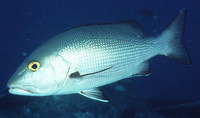|
Lutjanus bohar, Two-spot red snapper: fisheries, gamefish

| 해상도: 640x379
파일크기: 67770 Bytes
등록시간: 2008:04:15 18:26:50
|
Lutjanus bohar, Two-spot red snapper: fisheries, gamefish
Image of Lutjanus bohar, Two-spot red snapper, Tweekol-snapper, Maya-maya, Hamra, Bohar, Hamrah, Tingayog, Gingau, Madarag, Moos, Tagafi, Mos, Katambak, Mangagat, Guntul, Vara vara, Dobbeltplettet snapper, Aluman, Red bass, Red snapper, Twinspot snapper, Two-spot banded-snapper, Mylah, Twinspot red snapper, Twinspot snapper, Red bass, Twospot snapper, Bati, Damu, Vivaneau chien rouge, Lutjan rouge à deux taches, Lutjan rouge, Vara-vara, Noowa, Koukoru, Doppelfleckschnapper, Uposan, Upos-upos, Bambangun, Sidinean, Bara-fuedai, Te boingo, Te ingo, Djoumbouho, N
Randall, J.E.
AquaMaps
Point map
Order:
Perciformes
(perch-likes)
Class:
Actinopterygii (ray-finned fishes)
FishBase name:
|
^o^
동물그림창고 똑똑전화 누리집
^o^
|
|